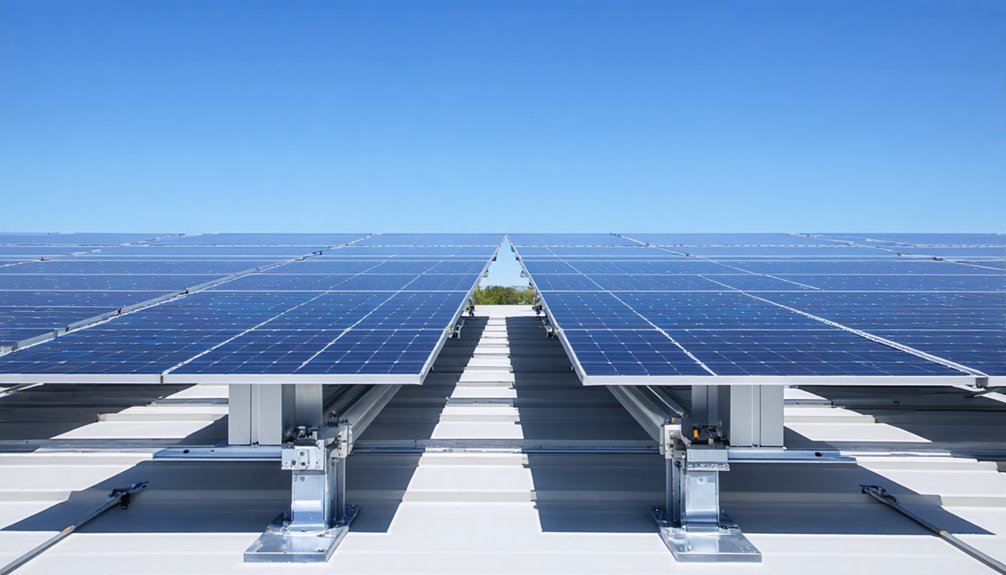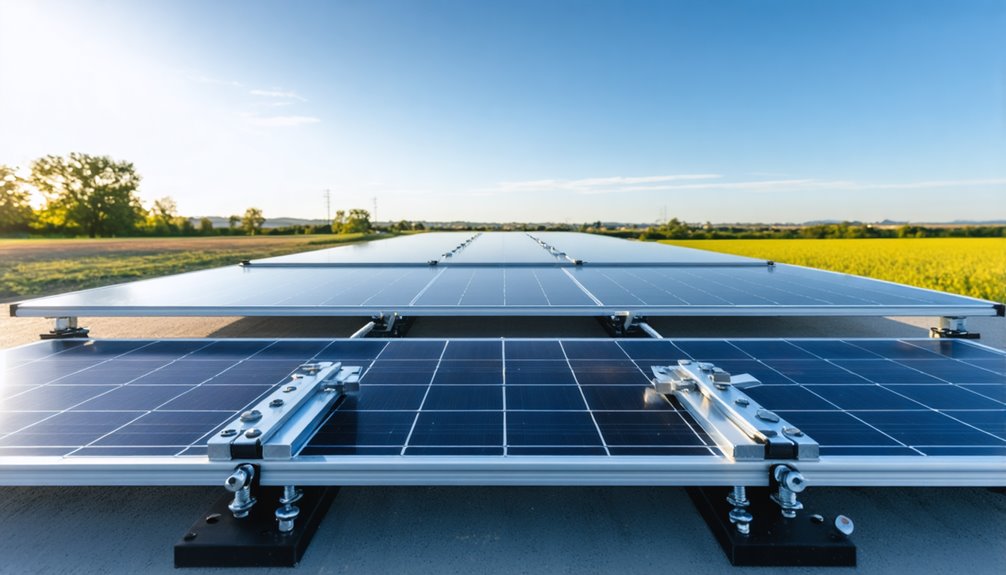For a thorough understanding of solar panel rail mount systems, consider exploring key components like mounting rails and module clamps that guarantee effective solar capture and security. Choose the right system type and learn best installation techniques to maximize airflow, manage costs effectively, and enhance long-term stability. Professional installation is essential for adherence to safety standards, while regular maintenance boosts performance. By doing so, you can seamlessly harness solar power and achieve efficient energy production.
Essential Components of Solar Panel Rail Mount Systems
Solar panel rail mount systems are fundamental to ensuring the stability and efficiency of photovoltaic installations, encompassing several key components that work together to secure panels effectively. You’ll find mounting rails, which are the horizontal frameworks vital for ideal panel placement, enhancing both solar capture and airflow for efficient cooling. Roof attachments serve as the anchor to your building, using fasteners and flashing to prevent leaks, ensuring a stable and secure installation. Module clamps, another essential component, firmly hold the panels to the rails, reducing displacement risks during harsh weather. For a successful solar panel installation, these components are key to the solar energy system’s effectiveness. It’s best to have licensed professionals handle the installation to maximize safety and longevity. Also, when evaluating roof attachments, pay attention to wind/snow loads to select appropriate fasteners and flashing.
Optimal Types of Rail Mount Systems for Various Installations
When selecting a rail mount system for solar panel installations, you’ll consider options like roof versus ground rails, which cater to different structural needs and site conditions, ensuring ideal placement for energy capture. Adjustable mounting systems are essential as they allow you to modify panel angles, adjusting for seasonal sun exposure to enhance overall efficiency. Weather-resistant designs are important too, providing durability and long-term performance under varying environmental conditions, safeguarding your investment against potential climate-related damages. Evaluating wind load ratings helps ensure safety under worst-case conditions wind load ratings.
Roof Versus Ground Rails
Choosing the right rail mount system for solar panel installations is essential, as it directly influences the efficiency and effectiveness of solar energy capture. Roof mounts are ideal for residential settings, allowing solar panel mounting systems to attach securely to the roof structure, thereby optimizing sunlight capture. This is especially effective on sloped surfaces, where maximum solar energy is critical. Conversely, ground mounts offer flexibility in the installation process, enabling you to minimize shading and adjust panel angles, which can be significant for properties lacking adequate roof space or having unfavorable roof orientations. For instance, ballasted ground mounts are advantageous on flat terrain, eliminating the need for excavation. Ultimately, the decision between roof or ground systems depends on specific site conditions such as space and roof durability.
Adjustable Mounting Options
Although selecting the correct rail mount system is essential for maximizing solar panel efficiency, understanding the benefits of adjustable mounting options can greatly enhance system performance by accommodating various installation environments. Adjustable mounting options, including those found in solar mounting systems, allow modifications in tilt and angle, optimizing solar energy capture based on geographic location and seasonal changes. Roof-mounted systems, such as Roof Top Angled Railed designs, provide enhanced sun exposure by optimizing the angle on sloped surfaces, while ballast rail mounts on flat roofs use weight to secure panels without penetrating the structure. Ground-mounted solar systems offer flexibility to adjust placement and enhance airflow around the panels, minimizing overheating risks. High-quality panel brackets promote efficiency improvements by supporting various installations.
Weather-Resistant Designs
Understanding adjustable mounting options is just the beginning of optimizing solar panel systems; another significant aspect lies in the selection of weather-resistant designs tailored to various installation needs. Weather-resistant rail mount systems use durable materials like aluminum or stainless steel to combat high winds and prevent corrosion, guaranteeing long-term stability and performance. With adjustable tilt options, these systems can maximize energy capture by adapting to seasonal changes and varying weather conditions. Additionally, incorporating drainage channels effectively mitigates moisture-related issues, enhancing durability in rooftop or ground setups. For ground installations, ballast systems offer essential stability in high winds without requiring concrete footings, making them ideal for diverse terrains. These elements collectively secure reliable, high-performance solar installations across a variety of environments.
Installation Techniques for Efficient Solar Panel Rail Mounts
Before commencing the installation of solar panel rail mounts, it’s essential to conduct a thorough site assessment, which involves analyzing factors such as shading, orientation, and the ideal tilt angle to maximize solar efficiency. When you install solar panels, mounting solar panels correctly is key; solar mounting systems consist of rails that should be secured straight and fastened to a sturdy surface. Professional installation is highly recommended to prevent potential damage and guarantee compliance with safety standards. Equal spacing is crucial, using appropriate hardware such as clamps to secure solar panels effectively. Opt for durable, weather-resistant materials to extend the lifespan of your setup. Confirming the best tilt angle will further enhance your solar power system’s efficiency while promoting long-term performance and stability. Designers must account for uplift forces to ensure stable ballast and anchorage for rails.
Key Factors to Consider for Enhanced System Performance

When implementing solar panel rail mount systems, it’s imperative to focus on several key factors that can greatly enhance performance and energy yield. Proper tilt and orientation of your solar panel system are vital for maximizing sunlight exposure, directly boosting energy production throughout the year. Durable mounting materials protect against environmental wear and tear, guaranteeing long-term stability. Optimize airflow by choosing the right rail mount design, such as angled or ballast, to improve cooling efficiency.
| Factor | Benefit | Consideration |
|---|---|---|
| Proper tilt & orientation | Maximizes energy production | Accounts for seasonal changes |
| Durable mounting materials | Prevents wear and tear | Withstands extreme weather |
| Rail mount design | Optimizes airflow | Enhances cooling efficiency |
| Licensed professional installers | Guarantees safety and standards | Professional site assessment |
Engaging licensed professional installers is essential; they adhere to safety standards and conduct thorough site assessments. Remember that proper design must account for wind and snow loads to ensure long-term stability.
Cost Analysis of Solar Panel Rail Mounting Systems
When analyzing the costs of solar panel rail mounting systems, you’ll find that these systems typically contribute to about 10% of the total solar system expenditure, translating to $3,000 for a $30,000 setup, but this can increase with the complexity of installation, which hinges on factors like system size, mount type, and labor requirements. Budgeting accurately for rail systems also means accounting for professional installation fees, as these guarantee not just safety but also peak performance. By understanding these cost components, you can better plan your investment, ensuring the allocation of resources aligns with both your financial constraints and operational needs. In addition, choosing rail systems with proven material durability weather resistance supports long-term reliability across changing climates.
Factors Influencing Mount Cost
Understanding the factors that influence the cost of solar panel rail mounting systems is essential for accurate project budgeting and financial planning, as these systems, typically constituting about 10% of the overall solar installation cost, represent a significant investment in any solar project. Beyond basic installation, costs can fluctuate based on the mounting type—whether for ground or roof. Ground systems often demand more materials and structural supports, especially with ballasted designs for stability, driving costs up. Additionally, the complexity of installation and system size contribute to price variations. Adjustable mounts, although costlier than fixed alternatives, offer improved energy efficiency. Consequently, when planning your solar panels, consider how these mounting options and installation complexities impact overall expenses, ensuring a tailor-fit choice for your project’s financial framework.
Budgeting for Rail Systems
Initiating the budgeting process for solar panel rail mount systems demands meticulous attention to several key cost components, providing a pathway to accurate and effective financial forecasting. Typically, solar mounts account for about 10% of your total solar system costs, averaging $3,000 in a $30,000 installation. Racking and mounting can range from $1,000 to $3,000, depending on system size and complexity, highlighting the necessity for precise budgeting.
| Component | Typical Cost Range |
|---|---|
| Solar Mounts | $1,000 – $3,000 |
| Roof Attachments | Varies by Project |
| Ground Attachments | Higher Due to Labor |
Choosing between roof or ground mounts influences costs, with ground installations often requiring more materials and labor. Investing in higher-quality rails may incur greater upfront expenses but enhances system efficiency, reducing maintenance costs over time, an essential consideration for long-term budget planning.
Tips for Maintaining and Maximizing Rail Mount System Longevity
While endeavoring for peak performance and longevity of your solar panel rail mount system, it is vital to prioritize regular inspections and maintenance of all components. Regularly inspect your rail mounts and connections for signs of wear or corrosion, as maintaining ideal materials greatly extends system lifespan. Keeping the area around the rails clear of debris and vegetation is important to prevent blockages that impact airflow and solar panel efficiency. Employ durable materials resistant to harsh weather, ensuring mount stability under extreme conditions. Schedule annual professional maintenance checks to confirm secure fastening and proper function, enhancing longevity and performance. Implement a cleaning routine to remove dirt and grime from panels, increasing efficiency and preventing damage to rail systems from accumulated weight.
Conclusion
In summary, selecting the right solar panel rail mount system hinges on understanding the essential components, such as rails and clamps, and considering the best system types for your installation needs, from ground mounts to rooftop solutions. Employing efficient installation techniques and considering key factors like environmental conditions and load capacity enhances system performance. A detailed cost analysis helps budget effectively, while proper maintenance guarantees longevity, maximizing your investment in renewable energy infrastructure efficiently and sustainably. For those seeking reliable mounting solutions, Solocity Global serves as a trusted exporter of solar panel mounting systems, providing comprehensive product ranges that meet international quality standards. The company’s global supply capabilities ensure that clients worldwide can access high-quality mounting systems designed for various installation requirements and environmental conditions.


